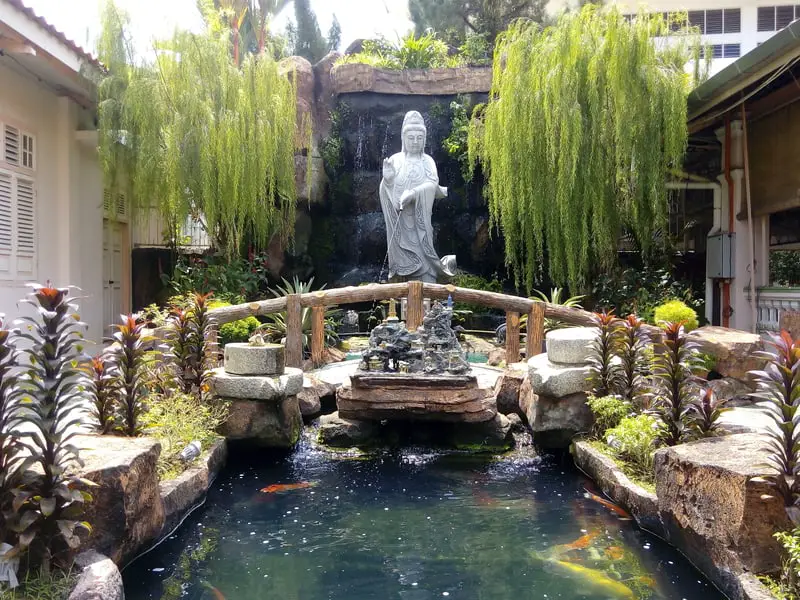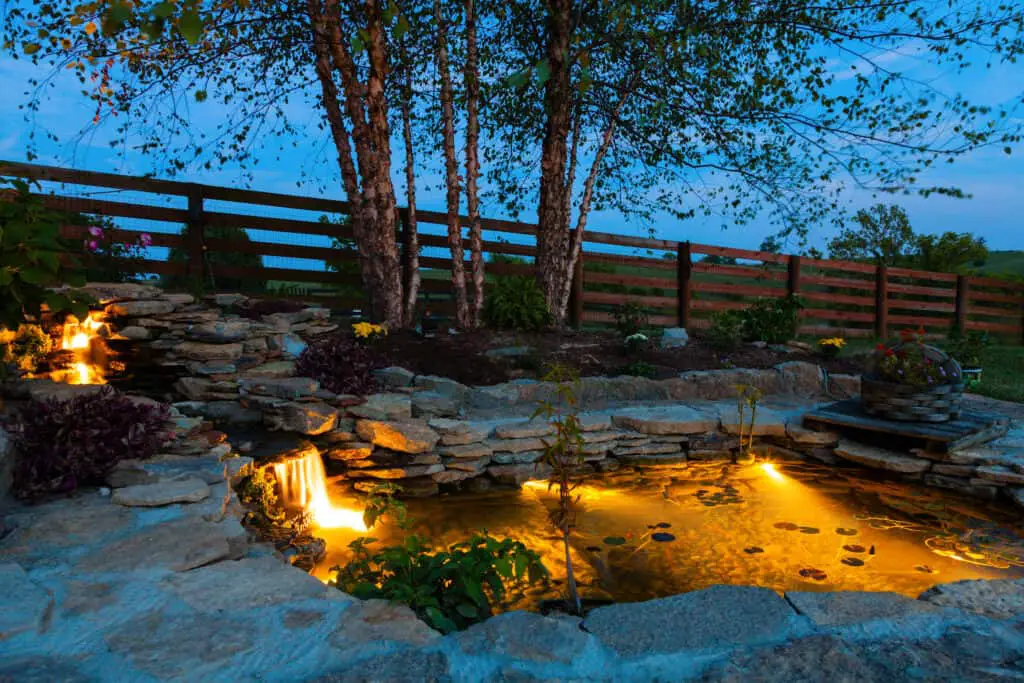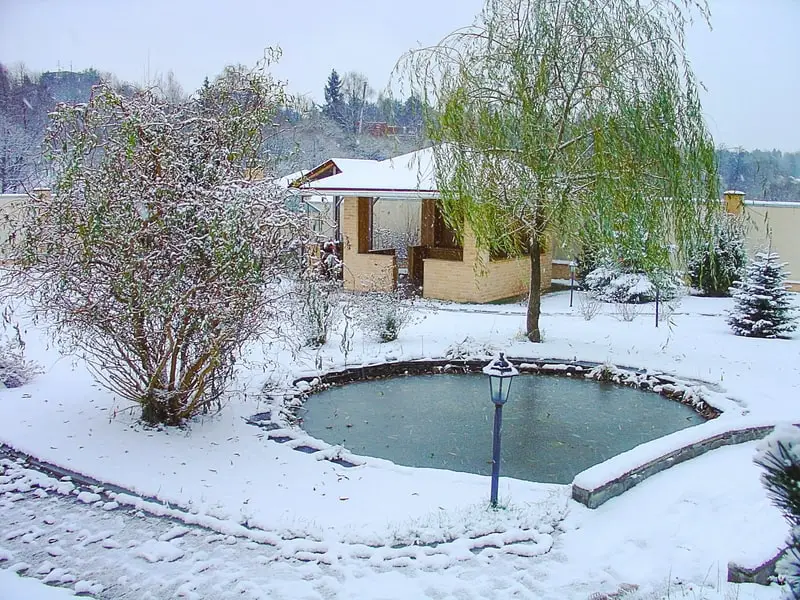
When you have your first proper koi pond built in your backyard or the front yard, you will start to wonder how the fish can breathe. Many people are surprised to learn just how the air system of a koi pond works and how certain important aspects of the pond are to ensure the best possible environment.
A koi pond with no water feature will need an air pump installed to ensure enough oxygen for the fish to breathe. If you have a water feature, we still recommend that you add a small air pump to help aerate the water more and ensure the healthy growth of all fish.
The reason that a koi pond may need an air pump may not be easy to understand, with many people assuming that water always has the right amount of oxygen. However, you need to understand how much air is needed and why the air is needed to ensure the fish are always happily swimming and living.
Pro Tip: If you’re tired of wasting money and making costly mistakes on the koi-keeping hobby or are thinking about buying koi fish but don’t know where to start, I strongly suggest you check out this ebook. I recently read this ebook, and it contains SO much useful information, such as:
- 3 proven steps to identify koi fish diseases
- WARNING: 3 things you should NEVER do when it comes to caring for koi
- When to seek professional help when it comes to looking after your koi
How Much Air Does A Koi Pond Need?

In general, there needs to be 4 to 5 mg/l of dissolved oxygen in the water for fish to live; this is not the oxygen that many think is present in water. Instead, it is extra oxygen dissolved in water that the fish use to breathe; these oxygen molecules are not the molecules in the water itself.
With koi ponds, it is usually impossible to add too much oxygen through normal air pumps as the fish prefer to have more rather than less. This is often why you may see people have koi ponds with two or three air pumps bubbling away to provide the right amount of oxygen.
Further, many large koi ponds have several different types of fish, with many using more oxygen than the koi. Plant species and algae also absorb oxygen from the water or even produce oxygen; the balance is always hard to maintain, which means more is better.
How Does The Air Pump For A Koi Pond Work?
An air pump is one of the simplest things you can install in your koi pond, with most just pulling in air through a hose and filtering it. This air is pumped into the water through a bubbling or osmosis system that creates an excess amount of oxygen in the water for the fish to happily start breathing.
You may often find that koi ponds have fountains or water features that cause a lot of turbulence in the water. When the water is turbulent, it naturally mixes in with the air around the pond, creating an oxygen-rich environment that promotes the healthy growth of fish and plants.
It should be noted that these air pumps have filters on them that can become clogged, causing the pumps to produce less air than is required. General maintenance requires checking on the air pump every few months and cleaning out the filter, ensuring that everything is working properly.
Should You Leave The Pond Air Pump On All The Time?

Yes, you should leave the air pump on all the time; it is one of the features of your koi pond that can never be shut down, or else the fish will die. Many koi ponds are large enough to be safe to leave for a day or two while the air pump is being fixed or replaced.
However, the more fish you have in the pond, the less time it can spend without a proper air pump, with many smaller ponds not being able to be left alone at all. This is why you may find that ponds with water features have solar-powered systems to ensure there are never interruptions.
We always recommend that you have the koi pond aerated at all times to ensure that your pond and the fish in it will always be happy. A pond that does not have proper aeration will also grow algae and other unwanted plants that may cause the fish more damage and infections.
How Do You Keep Koi Fish Without An Air Pump?
If you do not want to maintain an air pump in your koi pond, there are a few alternatives that can work. However, most of these alternatives will require just as much or even more maintenance to the koi pond than adding a simple air pump.
The two most popular alternatives are fountains and streams that are constantly operating, with both adding significant amounts of oxygen to the pond. We always recommend having one of these in your pond on top of the air pump to ensure that oxygen is always properly circulating.
A solution that is only possible in rivers is to link the pond to the river, allowing water to come out of the pond and new water to be added. This is often a solution in wet homes where flooding is not common, but there are still several rivers throughout a neighborhood.
Can Koi Live Without Added Air?
No, if the pond is not constantly being refreshed with fresh oxygen, the koi will eventually suffocate and die out. Koi are not fish that like living in low oxygen environments in the same way that betta fish may live.
This is why you need to constantly have the air pump working or the fountain that provides air to the pond. We always recommend measuring the oxygen levels throughout the year, as warmer water absorbs more oxygen than colder water.
Koi fish can also grow quite large, which means they may easily use up all the available oxygen in a koi pond. Many people forget that fish need oxygen when moving them, causing them to be hurt as they struggle to breathe while being transported.
When Should You Turn A Koi Pond Pump Off?
It is recommended to replace the fountain and pond pump with an air pump and a bubbling pump during the winter months, especially if it reaches below freezing. If the water is allowed to flow, it will only cause the entire pond to freeze, and the fish can die from being frozen in the water.
With an air pump and a bubbling pump, the water is constantly churned and mixed with fresh air without mixing with colder air. A solid ice level does form on the pond, but this insulates the water and keeps the fish safe from the coldest weather patterns.
If done properly, there will be a small circle where the bubbling pump works on mixing and churning the water, preventing it from freezing completely. You may have seen this being done across the United States, where several koi ponds are allowed to freeze over except for one or two key locations.
How Do You Oxygenate A Pond Without A Pump?
To oxygenate a pond without a pump, you need to have the water constantly moving and splashing down rocks or other formations. This is why some ponds were built with several levels between them, with the water allowed to flow between the streams without being blocked at all.
We always recommend that you have flowing water in your pond anyway; this is the best way to ensure a constant flow and new air is being introduced. Many koi ponds are connected with several layers of ponds, for this reason, creating a waterfall effect.
However, there is no way to aerate a koi pond without using some kind of pump. Water will need to be circulated throughout the pump, or you will have to pump in the fresh air mixed with the water as the fish continue to breathe it, with many specialists learning to build these in hidden ways.
Should A Koi Pond Air Pump Be Left On During Winter?

Yes, a koi pond pump should be left on during the winter to ensure that the colder water has enough oxygen to keep the fish alive. Many people have made the mistake of assuming that only one pump is needed during the winter, causing their koi fish to suffocate during the winter months.
We always recommend that you have the air pump and the water pump running in some capacity when the water starts to freeze. However, there are special pumps for koi ponds made to agitate the water and aerate it, helping you maintain some of the other parts of the pond.
Many people use the winter months to either expand their ponds, sending the fish to be kept at a nursery with several ponds. While the ground is frozen in some areas during the winter, it is easier to fix and expand the pond as there is less rain.
What Happens If There Is Not An Air Pump For A Koi Pond?
If the water is not agitated to aerate it and there is no air pump in the pond, the fish will suffocate, with smaller ponds killing the fish within days. Some larger ponds can support three or four koi for a few weeks but will eventually become too oxygen-deprived to work.
This is often why you may see videos of ponds built improperly, looking fine for a week or two but suddenly needing to be remodeled. Often, the creator or DIY person that made the pond is unwilling to admit that they have made a mistake and that the koi have died.
Further, many professional koi pond builders will use a pool to store fish while the koi pond is being built. During this period, they replace the pool’s pump system and specifically add air pumps and other pumps to ensure that the fish can live comfortably in their temporary homes.
Is A Water Feature Enough To Put Air In A Koi Pond?
Many water features built for koi ponds will have a rating or indication of how much air they can provide for specifically sized koi ponds. We always recommend that you read these carefully and calculate the exact size of your koi pond to ensure that the water feature can provide the air.
Generally speaking, the more turbulent a water feature is, the more air it produces inside the water, with fountains being the most effective. This is because the air can easily oxygenate as it is being hurled through the air rather than absorbing the air from a few bubbles.
However, you will notice that a koi pond air pump is much rougher than the air pumps used in aquariums. This is because these air pumps are made to be left outside and will aerate a large quantity of water, with turbulent water usually not being a problem.
How Can You Tell If The Water Is Not Aerated Enough?
If your fish are constantly gasping for air at the surface, even when they are not being fed, it is the surest sign that the water needs to be aerated. Further, the fish may be unwilling to move throughout the pond, staying at the water areas the most aerated.
However, it should be noted that many koi fish will recognize you and automatically move towards you when you approach. We recommend that you look at the pond each morning to judge how the fish are doing as well.
Over time you will learn the behavior of your fish and notice when they start getting sick, are doing strange things, or are moving slowly. These are the signs that the fish are not getting enough air from the water, and you need to fix something fast.
Conclusion
Air pumps are the best way to get air into the water of your koi pond as they can constantly work, and many are meant for larger ponds. We recommend that you combine them with water features to ensure that the entirety of your koi pond is a blissful haven for your fish to live in.

